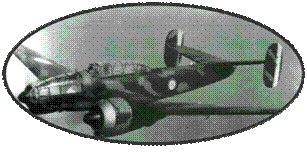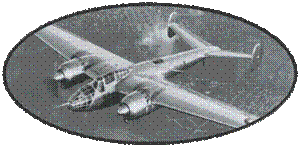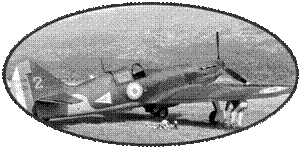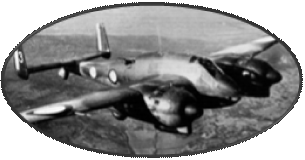The Air Ministry specification
F.7 / 30 was issued end of 1931. Its purpose is to build a day and
night fighter capable of a maximum speed of over 402 km / h and
including an armament of four machine guns. Recommended engine and
Rolls-Royce V12 air-cooled. The expected aircraft must present a
real break with the biplane fighters then in service. It must fly
about 40 km / h faster than the last fighters in unit, and this
with a double armament.
Seven prototypes are proposed
and the first flights range from February to September 1934. But
cooling problems related to the Roll-Royce engine push the final
choice to April 1935
Meanwhile, the company Gloster Aircraft Company, occupied by other
contrasts, could not respond to this new consultation. However,
in September 1933, the Gloster Gauntlet was chosen to equip the
RAF, and the Gloster design office offers an improved version of
the latter to meet the Specification F 7/30. This new interceptor
is equipped with a Mercury engine, a closed canopy, a Cantilever
landing gear and flaps on the Sup and Inf wings. Calculations have
shown that this derivative of the Gauntlet would have performance
close to the specification F.7 / 30. The company therefore builds
a prototype on private ground, designated SS37: the inaugural flight
took place on September 12, 1934.
The Air Ministry, aware of
the poor performance of the various competitors of the F.7 / 30,
is strongly interested in the prototype of Gloster, and in June
1935, the company gloster won the competition. A first contract
of 23 aircraft is signed followed in September 1935 by a second
order of 180 aircraft
The first Gloster Gladiator
Mk I flew in January 1937, and the 72nd Squadron of Tangmere received
its first aircraft on February 23, 1937. The last Mk I for the RAF
was delivered at the end of 1937. Production continued in order
to honoring contracts signed for export, with a first contract with
Latvia on May 27, 1937.
Following the feedback of
Escadrille, a MKII version appeared at the beginning of 1938. The
Mercury IX Watts engine and the two-bladed propeller were replaced
by a Mercury VIII associated with a three-bladed metal Fairey Reed
propeller. In March 1938, the Gladiator Gloster began to be progressively
replaced in units by the Hurricanes or Spitfires
At the end of 1937, the Royal
Navy became interested in Gloster Gladiator II instead of Hawker
Nimrod. Thus 38 Gladiators will be transferred from the RAF under
the Sea Gladiator designation. They are equipped with hooks.
When War broke out in September
1939, only four fighter squadrons (Nos.603, 605, 607 and 615) were
still equipped with Gladiators. Squadrons 607 and 615 are part of
the BEF, sent to France in November 1939. These two units are just
starting to transform on Hurricanes when the Germans attacked on
May 10, 1940. The Gladiators suffer heavy casualties against modern
german fighter planes and the units will be withdrawn to the south
of England to complete the conversion.
In April 1940, No. 263 Squadron
was sent to Norway to help British forces against a German invasion.
He will take part in the fight until June 7, claiming 26 victories
before being evacuated.
When Italy goes to war in
June 1940, Gloster Gladiators equip No.33 and 80 squadrons in Egypt,
and No.94 Aden. The Gladiator is on a par with the Fiat CR.42 and
has helped repel the Italian invasion of Egypt and defeat the Italian
forces in East Africa.
In Malta, the Royal Navy
had stored Sea Gladiators in crates to replenish squadrons. In May
1940, four Sea Gladiators were assembled by the RAF and for 10 days
(from 11 to 21 June), the Sea Gladiators were the only air defense
of the island, before the arrival of the Hurricanes. The Italians
organized only Three air raids on the island during this period
and due to a shortage of ammunition, the Sea Gladiators were used
to break up the bomber formations.
The No. 80 and No. 112 Squadron
Gladiators competed in the Greek campaign and achieved good results
against Regia Aeronautica, but were outclassed when the Luftwaffe
joined the battle. In 1941, No.94 Squadron Gladiators participated
in the "Battle of Habbaniyah" against Iraqi rebels who
besiege the RAF formation base.
The Gladiators continued
to serve in the Western Desert, but eventually disappeared from
the front-line services in January 1942. However, they will still
be used Squadron No.521 (meteorological) ensuring many flights until
January 1945.
The first export planes to
see the fight are those of the Chinese government, which had acquired
36 MK Gladiators to fight the Japanese invasion. Despite many accidents
due to lack of experience pilots, gladiator had some success in
the defense of Siuchow in 1938.
The Swedes also used the
Gladiator under the designation J 8 and J 8A Gladiator II. Some
have served with the Flygflottilj 19, a volunteer unit that fought
alongside the Finnish Air Force in the 1939-40 Winter War. The Swedish
unit fought for 62 days, destroying six Russian bombers and six
fighters for the loss of 3 Gladiators, including one on accident.
The Gladiators sold in Finland will mainly equip the HLeLv 26 unit:
its driving qualities will be leased, but the lack of protection
and self-closing fuel tanks will not make it popular.
Many of the RAF gladiators
have been delivered to Allied air forces, including Greece, South
Africa and Egypt where they will fly until the end of the war. Portugal
retained its Gladiators for the training of these pilots until 1953.
The only surviving Gladiator is preserved by the Shuttleworth Trust
in Old Warden, Bedfordshire.
Production ended in the spring
of 1940, with 768 units leaving the assembly line. of which 60 Sea
Gladiator.













